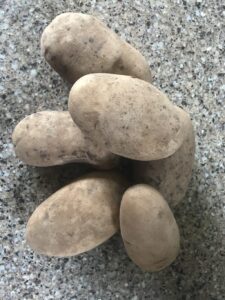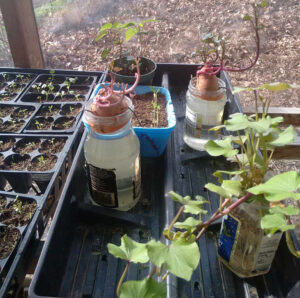- Like
- Digg
- Del
- Tumblr
- VKontakte
- Buffer
- Love This
- Odnoklassniki
- Meneame
- Blogger
- Amazon
- Yahoo Mail
- Gmail
- AOL
- Newsvine
- HackerNews
- Evernote
- MySpace
- Mail.ru
- Viadeo
- Line
- Comments
- Yummly
- SMS
- Viber
- Telegram
- Subscribe
- Skype
- Facebook Messenger
- Kakao
- LiveJournal
- Yammer
- Edgar
- Fintel
- Mix
- Instapaper
- Copy Link
 A version of this column first ran in the Roane County (WV) Reporter and Times Record. Support local journalism! Subscribe to your local newspaper. This is one of a series of blogs for new gardeners. Start reading the whole series here: Part 1.
A version of this column first ran in the Roane County (WV) Reporter and Times Record. Support local journalism! Subscribe to your local newspaper. This is one of a series of blogs for new gardeners. Start reading the whole series here: Part 1.
Now that we’re into winter, and having already discussed ordering seeds for next year, there isn’t too much to talk about involving gardens… except how to use the produce you hopefully have stashed in your pantry, root cellar or garage, freezer or fridge. I’m going to do a few columns on this, starting with potatoes. Potatoes are doubtless the most versatile of the things you can grow—and they’re also easy to store (in a cool moist place) as well as easy to grow. I therefore rate them at the top of my garden list.
First I’ll say that I don’t consider it necessary to peel homegrown, unsprayed potatoes—except late in the winter or spring, when the skins get thick and gnarly and sprouty. And don’t toss the littlest potatoes; save them separately. These are nice to put next to a roast, or toss into a soup (chopped as appropriate for size).
The most obvious and easiest choice is to bake the potatoes, and serve them with butter and salt. I like to bake potatoes, or sweet potatoes or butternuts when I have the oven running anyway for something else. Then I scrape out the butternut flesh and stash it in the fridge; the sweet potatoes and potatoes can just go in the fridge whole. I sometimes give any of these to my chickens. I may dice up cold baked potatoes and use them with onions and garlic in omelets.
Of course mashed potatoes are on the list…just chop up the potatoes, boil them until soft, and mash them with a little butter and milk. You can use a machine, but I just use a hand masher.
Probably the thing we use most of our potatoes for in my house is home fries, which we have almost every morning, with eggs and toast. For this you dice up potatoes to the size of peas or marbles and fry them in a fair amount of oil, on low to medium heat, adding chopped onions after they have made some visible progress in frying, then minced garlic a little later. You can add salt from the start, and throw the potatoes into the pan while it’s still cold. My husband likes to add some hot pepper—minced fresh ones in season, or pickled peppers if we have any, or dried if we don’t. I like to add some minced sweet potato (the orange ones—the purple ones don’t soften when fried). Or sometimes I use celery (which takes a long time to fry so it must be minced and tossed in with the potatoes, early on—same with sweet potatoes). Sometimes I add apples or green peppers, which go in with the onions.
Potatoes also go well in stews. I like to make a stew with venison or chicken, carrots, onions and garlic, and potatoes or rice, along with celery or something else green, and some spices. Then I turn the leftovers into a pie. This requires only making a pie dough and adjusting the liquid level (maybe adding some flour to make the liquid into gravy).
All right, fine—I hear many of you whining that you don’t know how to make pie dough. It really isn’t hard. Here’s how I do it: for a two-crust, nine-inch pie, mix a cup each of whole wheat flour and white flour—pastry flour is best but not critical. Add a teaspoon of salt if your fat is salt-free, but if you’re using salted butter, cut it back to about a third of a teaspoon. Cut up the butter—two-thirds of a cup or a little less (but more if you’re using all white flour). Use a pastry cutter or a fork to chop the butter into little pieces and stir it into the flour mix. Keep cutting up pieces of butter into smaller pieces until it looks like a coarse meal. Yes, you can use shortening or margarine, but that stuff is really unhealthy. Now add water—start with a quarter cup and add a tablespoon or two at a time, working it into the dough, until you have a ball of dough without dry spots. This is the only tricky part, because if it’s too dry it will crack when you try to roll it out; if it’s too wet it will stick to things and make a heavy, non-flaky crust. It may take practice to learn the right consistency.
Divide the dough into two balls, one a bit bigger than the other (for the bottom crust). Bag them and put into the fridge to chill for at least an hour, or no more than three or four days. When you’re ready to use it, roll it out with a rolling pin (you can even use a bottle if you don’t have a rolling pin) on a floured counter until it’s the right size. You will want to flour the top too, so the pin doesn’t stick to it. A spatula may help remove it from the counter to line your pie pan (usually ungreased). After filling it, roll out the smaller ball to fit the top, crimp around the edges to seal it, and cut a few slits in the top to let it exude steam while baking.
One more thing I do with potatoes is make hash. Dice the potatoes and fry them with some burger and onions and maybe green pepper, and garlic, then dump in some beans—I like to use kidney beans. Cook a little more, then top with a little grated cheese, maybe parmesan. Quick and easy.
Read the rest: Part 1. Part 2. Part 3. Part 4. Part 5. Part 6. Part 7. Part 8. Part 9. Part 10. Part 11. Part 12. Part 13. Part 14. Part 15. Part 16. Part 17. Part 18. Part 19. Part 20. Part 21. Part 22. Part 23. Part 24. Part 25. Part 26. Part 27. Part 28. Part 29. Part 30. Part 31. Part 32. Part 33.













